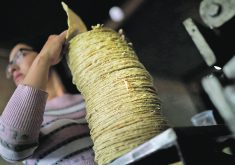University of Alberta study will explore 30 varieties of canola and plants such as cabbage looking for disease resistance
Scientists seeking to slow the spread of a plant parasite in Alberta that can stunt and kill canola crops have launched a five-year research project to genetically boost resistance to the disease.
Clubroot has infected 44 out of 66 municipalities where canola is grown, said Stephen Strelkov, a professor of plant pathology at the University of Alberta.
“Typically, when we do our surveys here in Alberta, we probably find it in about 300 to 350 new fields per year.”
The core funding of $1.25 million for the project is being provided by BASF, he said. Scientists hope to further leverage that amount by obtaining funding from sources such as government agencies, he added.
Read Also

Manitoba community projects get support from HyLife
HyLife Fun Days 2025 donated $35,000 each to recreation and housing projects in Killarney, Steinach and Neepawa earlier this fall.
Clubroot is caused by single-celled protozoans that attack the roots of canola plants. They form tumours that distort the shape of the roots, making them less able to absorb water and nutrients and potentially stunting and even killing the plants, said Strelkov.
“It’s a simpler organism than a fungus, but still, it has many similar characteristics…. We call it an obligate parasite, so it can only grow and reproduce on a living host. And then when it’s not in the host, it just survives in these dormant spores, like resting spores.”
Although most cases of clubroot in canola are mild to moderate, about 10 percent are severe, he said. “We’ve had a few fields where it’s been nearly complete or complete yield loss, and the problem is that once it’s present in the field, it becomes an issue that has to be continuously managed.”
New clubroot strains have been found in more than 300 fields in Alberta, where it was first detected in canola in 2003. Strelkov likened it to a kind of arms race in which the parasite is constantly evolving ways to overcome the defenses of resistant varieties of canola.
“So, even if you develop a resistant variety, you have to be careful to use that resistance as part of an integrated management plan because if you just grow the same resistant variety over and over again, you’re asking for trouble.”
Researchers will explore 30 varieties of canola and plants such as cabbages for resistance to clubroot, along with pathogen material the university has collected over the years, said a statement.
“The varieties were chosen for their promise in preliminary testing done at the U of A, where they’d proven resistant to a diverse set of pathotypes. Plant material held by BASF will also be analyzed and compared with U of A material and cross-bred, if necessary, to introduce new resistance genes.”
Such genes will be provided to BASF to breed new clubroot-resistant cultivars for its customers. Ongoing investment and stakeholder collaboration is crucial to driving the canola industry forward, Brent Collins, BASF Canada head of seeds and traits, said in a company statement.
Strelkov said clubroot is believed to have originated in the Mediterranean region of Europe. It was likely accidentally brought to Canada by settlers in the 19th century, infecting cruciferous plants, such as cabbages and broccoli, that are related to canola.
It was well established by the early 20th century, mainly appearing in market and home gardens in Ontario, Quebec, the Maritimes, and the Lower Mainland of British Columbia, he said. “But it wasn’t really an issue on the Prairies until it showed up in canola in 2003, and from there, it’s been spreading.”
It has been detected at an increasing frequency in Saskatchewan and Manitoba, as well as parts of the United States such as North Dakota, he said.
“So, it’s becoming more prevalent, but still, the vast majority of the cases are still in Alberta.”
Part of the difficulty in fighting the spread of clubroot in canola is it propagates through resting spores in soil that are hard to eradicate. For example, it is difficult to eliminate using chemicals, although potential strategies could involve increasing soil PH by adding lime, Strelkov said.
“And those kinds of tools can help, but I do think that genetic resistance will remain as a backbone of management, and these other tools can help increase the sustainability of the resistance and longevity. But we don’t really have anything that’s economically feasible, for instance, in terms of soil drench fungicides and so on that could be used for canola production soils.”
















